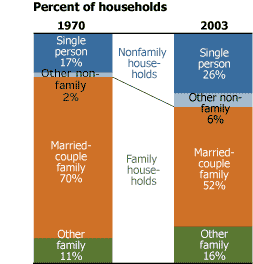How Does the Us Census Bureau Define a Family
Editor'southward Note: This commodity is excerpted from PRB'sPopulation Bulletin, "Population: A Lively Introduction," fourth edition. A revised version of this Bulletin was released in January 2021, "Population: An Introduction to Demography."
Individuals relate to order through their families and households. When these units add together or lose members — or when the household members grow older, divorce, or marry — there can be profound social and economic consequences. Divorce tin bring financial hardship. Wedlock can add additional income, also as stepchildren or mothers-in-law. The birth of a child can bring new financial expenses, but it also can encourage stability.
Households and families are basic units of assay in demography. They are not the same thing. A household is equanimous of 1 or more people who occupy a housing unit of measurement.1 Not all households incorporate families. Under the U.S. Census Bureau definition, family households consist of 2 or more individuals who are related by nascency, marriage, or adoption, although they also may include other unrelated people. Nonfamily households consist of people who live alone or who share their residence with unrelated individuals.
These official definitions exercise not necessarily reflect changing attitudes about wedlock, childbearing, and the roles of men and women. Households that consist of unmarried couples living together and gay and lesbian couples, for example, would exist counted equally nonfamily households even though they might share many characteristics of a family. If these couples live with children from their current or a previous relationship, the household moves into the family category. The Demography Bureau has been exploring new means to describe and measure out Americans' living arrangements beyond the family unit/nonfamily dichotomy, with terms such as cohabiting or unmarried couples and POSSLQs (persons of the opposite sex activity sharing living quarters).two
An private's living arrangements commonly change at different stages of life. In the traditional scenario, a person starts out in a family household, leaves to create a new household alone or with friends, then forms a family unit household with a spouse and eventually children. In old historic period, an individual may live in a single-person household once more because of divorce or decease of the spouse. Of class, not everyone follows this pattern; many people skip or echo stages.
The average size and composition of households are highly sensitive to the age construction of the population. But they also reflect social and economic changes. An economic clasp may prolong the fourth dimension adult children alive at dwelling; a ascent in the divorce charge per unit may increase the number of single-person households. Relaxed social rules about marriage may boost the number of unmarried couples setting up business firm.
In the The states, the mix of household types has changed enormously over the concluding iii decades. One of the most notable changes is the failing proportion of family households and the rise in single-person households. In 1970, 81 percentage of all households were family unit households, just this was down to 68 percent by 2003.
The retreat from marriage and the full general aging of the population are increasing the number of unmarried-person households. Americans are waiting longer to get married, if they choose to marry at all. Married couples are more than likely to get divorced than they were in the 1970s. More of America's elderly live lone subsequently the death of a spouse. In 2003, 26 percentage of all U.S. households consisted of just i person, compared with 17 percent in 1970 (see effigy). Many European countries have seen a similar rising in single-person households for similar reasons.
U.S. Households, by Composition

Sources: U.S. Demography Bureau, "Households by Size: 1960 to Present" and "Households past Type: 1940 to Nowadays, released June 12, 2003;
world wide web.cesnsus.gov/population/socdemo/hh-fam/tabHH-4.xls and world wide web.census.gov/population/socdemo/hh-fam/tabHH-1.xls, accessed Sept. thirty, 2003); and PRB analysis of data from the 2003 Current Population Survey (March supplement).
The U.South. baby-boom generation hastened many of the changes in the makeup of U.S. households. When the offset of the baby-blast generation entered their late teens and early 20s in the 1960s, they moved out of their parents' homes and gear up their ain households, often alone or with housemates. They waited longer to marry than the previous generation, and they were more likely to divorce.
Americans born after the baby smash are delaying marriage even longer. In 1970, 89 percent of women ages 25 to 29 had been married at to the lowest degree once. In 2002, only 60 pct of women ages 25 to 29 had been married. The choices these women make most spousal relationship and childbearing help determine the present and hereafter makeup of U.S. families and households.
References
- Jason Fields and Lynne Thou. Casper, "America's Families and Living Arrangements," Electric current Population Reports P20-537 (2001): one.
- Suzanne M. Bianchi and Lynne M. Casper, "American Families," Population Bulletin 55, no. iv (2000): iii-6 and 14; and Jason Fields, "Children's Living Arrangements and Characteristics: March 2002," Electric current Population Reports P20-547 (2003).
This article is excerpted from PRB'due southPopulation Bulletin, "Population: A Lively Introduction," fourth edition. A revised version of this Bulletin was released in Jan 2021, "Population: An Introduction to Census."
Source: https://www.prb.org/resources/whats-a-household-whats-a-family/
0 Response to "How Does the Us Census Bureau Define a Family"
Enregistrer un commentaire